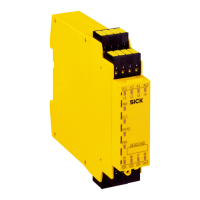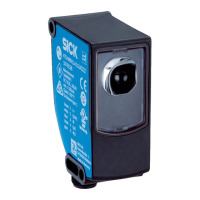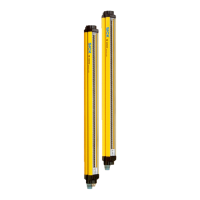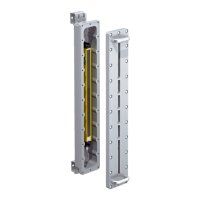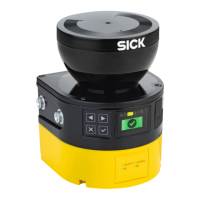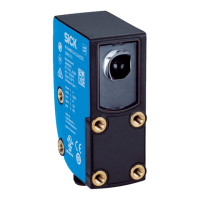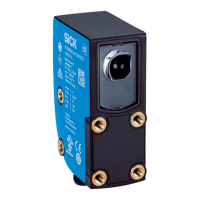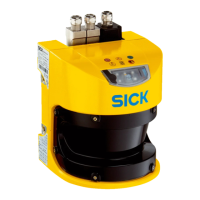
Do you have a question about the SICK OLM100 and is the answer not in the manual?
| Brand | SICK |
|---|---|
| Model | OLM100 |
| Category | Security Sensors |
| Language | English |
Details the information required for the safe system's lifecycle, covering components, planning, installation, checks, configuration, commissioning, maintenance, and troubleshooting.
Covers information regarding the Safe Linear Positioning safety system and its components, with priority given to safety system instructions in case of contradictions.
Explains the symbols and conventions used in the document, including safety notes (DANGER, WARNING, CAUTION, NOTICE) and instructions to action.
Provides links to additional online resources such as other documents, software, project files, and guides related to the safety system.
Emphasizes that the provided information is a basis and requires qualified staff for project planning, risk assessment, and validation.
Describes the system's design for reliable detection of linear drive systems' position and its role as a safety component guaranteeing a safety function.
Warns about potential mounting errors and the maximum permitted speed limit of 4,000 mm/s for the system.
Specifies that configuration, installation, connection, commissioning, and servicing must be performed by qualified safety personnel only.
Details product identification on packaging and application examples like skillet conveyors, cranes, and gantry robots for safe position monitoring.
Lists the core components of the Safe Linear Positioning system, including OLM100 sensors, Flexi Soft controller modules, and system plugs.
Highlights the necessity of additional components like bar code tape and emphasizes that all safety-related components must meet PL e/Category 4 requirements.
Explains the system concept with sensors and controller, dividing the system into modules and defining its limits as ending at the Flexi Soft controller terminals.
Details safety functions like Safe Stop 1/2, Safe position monitoring, Safely Limited Speed (SLS), and Emergency Stop capabilities of the system.
Describes the 'safe state' where switching outputs are off, initiated by triggered safety functions, connection problems, or internal faults.
Outlines manufacturer duties like risk assessment, validation, and component integration, and explains performance level calculation using SISTEMA.
Covers the operating entity's role, the necessity of new risk assessments for changes, and design information for the safety system and sensors.
Details integrating the system into electrical controls, testing plans, and permitted modifications, emphasizing safety checks after changes.
Explains fault detection mechanisms for bar codes, including illegible codes and gaps, and how the system reacts to these faults.
Provides instructions for mounting the pre-assembled sensor unit, emphasizing correct positioning, distance from the bar code tape, and safety screws.
Details requirements for mounting the self-adhesive bar code tape, including orientation, gap specifications, and handling of disruptive points.
Specifies that the Flexi Soft safety controller must be mounted in an environment meeting enclosure rating IP54.
Covers general electrical installation requirements, measures to prevent common-cause failures, and the wiring principle for components.
Details the pin assignment for the safety controller modules (CPU, XTIO, MOC1), showing the connection of inputs and outputs.
Describes system interfaces and signals, categorizing them into safety and standard interfaces, and defining test signals and their meanings.
Explains signals for PDS (SR) drive, optional safe brake control, safe SLS request, emergency stop, and restart interlock.
Covers chapter structure, software/firmware requirements, general configuration procedure, and pre-configured project files for the safety system.
Details configuring the BG100 motion sensor interface, speed limits, max speed, speed filter, and assigning speeds to position ranges.
Explains configuring position ranges, assigning speeds to profiles, setting up safe cams (SCA), and configuring stop ramps for safe operation.
Covers adding safety functions, activating safely limited speed via internal/external signals, configuring override functions, and controlling safety outputs via PLC.
Describes CPU logic pages including Interface, Safe Outputs, Safe Position/Diagnostics, and Stop/start/reset, detailing function blocks and diagnostics.
Details motion control logic pages like Position_Cross_Check, Position_Monitor, and Safe Stop, explaining their functions and views for system monitoring.
Provides notes on the Flexi Soft logic editor, covering creating/deleting links, jump addresses, logic verification, and configuration transfer.
Emphasizes safety precautions, ensuring the machine is checked by qualified personnel and operates with a functioning protective device.
Outlines requirements for thorough checks before commissioning, after changes, and during operation to ensure compliance and system effectiveness.
Addresses potential system switches to the safe state due to high EMC levels and advises user measures for related problems.
States that the sensor unit can only be exchanged as a complete unit and repairs must be performed by the SICK Service team.
Instructs to follow applicable national disposal regulations, emphasizing recycling of constituent materials during disposal.
Presents key technical specifications including SIL claim limit, performance level, PFHD, response times, resolution, and environmental data.
Provides detailed input specifications for the XTIO module, including voltage levels, current, capacity, switching current, and pulse filters.
Includes dimensional drawings of the OLM100 Hi sensor and details response times, including overrun calculation for the entire system.
Explains stopping time calculations in case of drive faults and defines Flexi Soft cycle time, including formulas and operand meanings.
Defines the maximum data reception interval as an adjustable timeout period for valid position data, impacting response time.
Lists complete sets and retrofitting sets for Safe Linear Positioning, specifying part numbers, resolutions, and included components.
Details ordering data for connection cables for OLM sensors, specifying types, lengths, and part numbers for straight and angled connectors.
Provides a checklist for initial commissioning and recurring checks, covering ambient conditions, mounting, electrical installation, and plausibility signals.
Covers checks for SSI interface baud rates, drive system compliance, brake control, and external SLS request signals for safety.
Includes checks for maximum speed, safely limited speeds (SLS), stop ramp configuration, and impact of parameters on response time.
Covers checking position ranges, speed/position profiles, response time, Flexi Soft configuration verification, and CRC checksum documentation.
Details test procedures for evaluating test signals during standstill, forward movement, and backward movement for safety system checks.
Covers checks for external SLS request, emergency stop actuation, and faults on the transmission path to ensure proper safety function operation.
Focuses on checking for proper bar code tape application, signs of manipulation, and ensuring the safety system is not tampered with.

